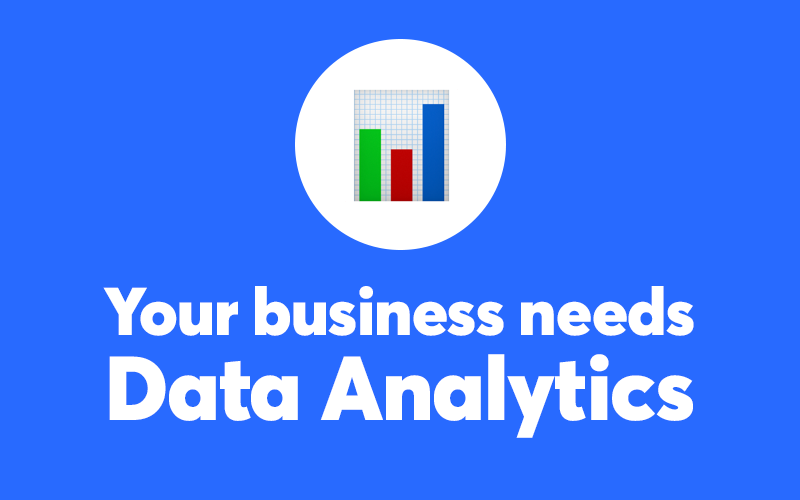Data Analytics is becoming one of the distinctive advantages helping companies stand out from the competition and blossom. The better you can leverage different data types, analyze it, and implement the takeaways, the bigger the chances to steal a march on others.
Being a key asset in any business, data is revolutionizing how most companies across multiple industries operate. According to Statista, by 2023, the world of Big Data is estimated to be worth over $77 billion. Hence, businesses need to be data-driven and have a solid data strategy to follow.
In this article, we will focus on data analytics and its paramount role in every business. You’ll know how to benefit from using data. Let’s go!
Defining data analytics
The process of gathering and assessing all types of information refers to data analytics. It is used to extract business-related records, analyze existing patterns or trends, and gain insights for further implementation.
There are several types of data analytics, each focusing on its different facet:
- Predictive. This type focuses on analyzing information that can bring insights into future business outcomes. The previously gathered data is assessed to set predictions for the next month, quarter, or year.
For example, your sales team uses HubSpot. Collecting all sales records opens up a door to evaluate sales performance, optimize it, and gain many more insights that can (and should) be used to predict upcoming performance trends. Expect for this, predictive analytics help to investigate other fields – from consumer satisfaction to risk management.
- Descriptive. Such analytics focuses on previous events and assesses data to gain information on critical metrics and KPIs to understand your business better.
As an illustration, you may use BigQuery as a data warehouse of your choice. With a BigQuery integration, you import all the data from several sources and tools in one place. Eventually, you can build dashboards, improve reporting, gather critical numbers, share all the insights with the company.
- Diagnostic. This one provides information on different events and the reason they occurred. Once you have done the descriptive analysis, the diagnostic type provides you with the reasons for certain outcomes.
For instance, your company has witnessed increased traffic to your blog last few months. By using diagnostic analysis, you get insights into why it has increased and the exact reasons for that. It’s helpful because you cannot always see a clear correlation between some actions you did; the reason might hide deeper.
- Prescriptive. The last type combines data from all three types mentioned, giving actionable and effective business information to analyze. Prescriptive analysis can help businesses create and implement future growth strategies.
Let’s say you want to rethink your marketing strategy. You need to collect tons of data about your current marketing performance, customers, and budgets. With a prescriptive approach, you’ll be able to make your marketing strategy data-driven and focus on efficient tactics eventually.
Why does your business need data analytics?
Let’s look into data analytics advantages and why the latter is so critical for your business.
Source: FinancesOnline
With data analytics, companies get a deep understanding of how the business is doing, what it lacks, and how to improve it.
The advantages of data analytics are not only easily accessible but also vital for all types of businesses. With analytics, your company can cut on expenses, boost productivity and make sure you are not leaving any important data asset behind.
5 benefits of using data analytics for business
From the section above, you’ve understood that the impact of data analytics and Big Data on companies is immense. Here are 5 beneficial applications of data analytics in your business.
You get more precise marketing
Data analytics help companies to get to know their target audience, what they like, what they lack, and what makes them choose the brand.
By analyzing potential consumers, companies get valuable insights into crafting more precise campaigns, be it video marketing, social media, PPC, or email marketing. Data analytics shows what worked and what didn’t, saving costs and providing better results for the promotion of your company, and increasing brand awareness.
You make better decisions
Driven by data, you can sharpen their skills in decision-making and take on a business strategy that will definitely bring on greater outcomes.
Companies can leverage this information to improve project management, prioritize features, eliminate wild guesses, and ensure each decision is fully data-driven by understanding target audiences, their preferences, and behavior.
You obtain improved efficiency
Things get pretty straightforward when it comes to using data analytics. Businesses get an opportunity to enhance many organizational and financial processes, efficiently rendering them and, at the same time, cutting costs. By conducting financial analysis, companies can deploy existing resources more efficiently.
You streamline data reporting
With such a vast amount of data, it can be tricky when it comes to data reporting. With analytics and diverse data integration tools, businesses can ensure that each data asset is noted, assessed, and reported on time. Besides, with infographics and charts, each team member gets a chance to see and evaluate the results of marketing campaigns, for instance.
You increase customer service standards
Companies comprehend what their consumers prefer and provide them with timely and accurate responses emphasizing data analytics. On another note, with all the team having access to analytics, customer support can now have a better consumer focus and provide a consistent and high-quality service.
Becoming a data-driven company
Source: Tiempo Dev
While data analytics is great, with such an overwhelming amount of information to process, it is only a part of becoming a data-driven business.
First things first, every business needs a data strategy. It’s critical given the volume of data and the constantly evolving updates on how to deal with it. A data strategy is not about collecting as much information as possible and using every available channel.
Here, it is more about understanding what a business plans to do with all the received data and what goals it is looking to achieve.
- Start with a strategy. It doesn’t really matter what data your company collects, what channels you use, and what new ways of collecting have recently appeared on the market. In fact, even the amount of data a company has makes no sense unless there is a good strategy. The latter is all about what a business is planning to achieve and how data analytics can help it get there.
- Collect information. Once you’ve defined the purpose of analyzing data, the next step will be to identify which data you need to collect, from which sources, and how to do it. Depending on the pursued goal, some businesses will just need to focus on social media performance, while others will have to use more advanced metrics.
- Ensure relevancy. It’s vital to make sure all the collected data is relevant and understand how to use it. In reality, to achieve a certain goal, your business will probably only need certain information from a certain source without the need to investigate every possible source of data.
- Make the right use of data. Having collected the relevant information, there’s a need to have a purpose of usage. You need to have a clue why you’ve been collecting all this data as well as be able to utilize it. Think of services, tools, metrics, KPIs, goals because your data analytics have to be well performed.
- Present information. Regardless of the data volume, the company has collected, it is vital to use charts and infographics to visualize the findings and ensure everyone can get a clear understanding of the analysis results and how they will act on them later.
- Act on it. Once the data is gathered and assessed, the last crucial step is ensuring there is a clear action plan on how to benefit from the findings, how they will help the business, and how the initial goal will be achieved with all the given information.
A key thing to remember is that there is no single data type that is better than the other. The data critical for your business needs might be less useless for other players on the market and vice versa.
With the sheer volume of information, the most important thing when working with data analytics is utilizing it strategically and finding the one that is beneficial for your company.
Conclusion
Data analytics is a way to streamline all the business processes, make better decisions, generate leads, and ensure the marketing efforts are on point.
The key takeaway, however, is not about collecting all available data but developing a smart and relevant data strategy. It makes your company data-driven. If you do it right, you will never get drowned in the constantly emerging data and be able to resolve critical business issues in the most practical and easy way.







 BONUS:
BONUS: The Challenge: Join this free course and I guarantee that after 5 days you will have the necessary skills to start generating B2B clients Growth Hacking and Prospecting techniques.
The Challenge: Join this free course and I guarantee that after 5 days you will have the necessary skills to start generating B2B clients Growth Hacking and Prospecting techniques.